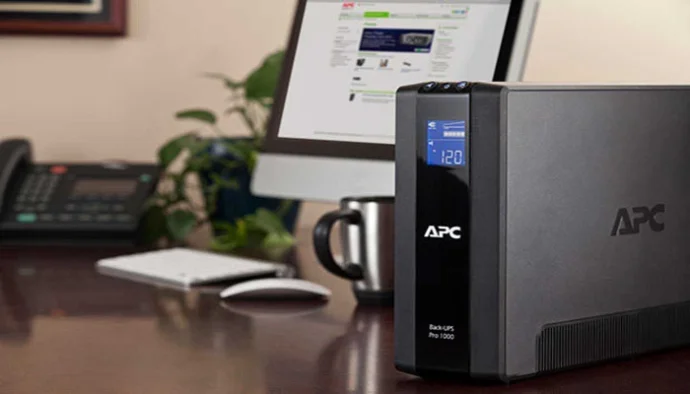Buying a Home Office UPS for Remote Workers
With more remote working, electricity demand on the National Grid has shifted somewhat, from concentrations in city centres and office parks, to more residential areas. If you have been working from home and track your home energy usage, you will probably have noticed a rise in your electricity usage and bills.
Working from home, whether you run a home-based business or have relocated as a remote worker, means that you could be running either an entire IT system or parts of your company’s IT infrastructure within your home. Whilst the spring and summer months in the UK tend to allow for a more stable electrical supply, generally, it is in the autumn and winter months when most of us can expect to experience more frequent power surges, brownouts, and mains power supply interruptions.
Weather plays an important role here. Not just the drop in temperatures, which will lead to increase demand for heating, but less daylight will mean we have to turn on the lights earlier. Weather extremes are also more common in terms of lightning, storms, and windy days. As the grid is put under more demand and pressure, equipment failures occur. There are several hundred thousand sub-stations on the electricity grid, and it is not uncommon for one of these to fail, leading to a complete mains power supply loss.
So how do you protect the computer and IT systems you have migrated from your office to your home environment from power related problems?
Battery Backup Solutions
If you use a laptop or hybrid product such as a Microsoft Surface, then you have the luxury of a built-in battery that will allow you to run through power interruptions. Possibly with enough runtime to last for several hours. This can be an acceptable approach if you work remotely and without the need for internet or network connectivity.
However, if you must use the internet you have probably got a broadband router, dedicated, or shared with the rest of the household and this will go down if there is a power interruption. A standard BT broadband hub will be powered from an AC/DC adaptor supplied with the device. This will generally plug into a UK-style BS 1363 wall socket, power strip or extension lead. Broadband access does not provide just the ability to email, message and conference call but for many now running Microsoft 365, connection to the internet provides Cloud backup and may be part of your business continuity and disaster recovery plan. If your laptop goes down or is stolen, you have got a backup and can access your files quickly.
Some users will have brought home their desktop PC from the office and this will not have any built-in battery backup. The main computer unit and terminal screen will be AC powered via a power cord that will plug directly into UK-type wall socket. At work, AC power source may or may not have been powered from an uninterruptible power supply; either a centralised UPS for the entire company or individual uninterruptible power supplies in a decentralised UPS installation with one backup UPS installed for each PC and workstation. When you relocated to your home office, you may or may not have brought your UPS system with you.
To learn more about the potential for power interruptions in your area, it is best to contact your local energy provider and network operator. Their website will provide latest status information and their Twitter accounts can also provide useful information.
More info: https://www.energynetworks.org/operating-the-networks/whos-my-network-operator
Home Office UPS systems
As in a work environment, the only way to completely protect an IT network to provide power protection and battery backup for all the critical components. In a home office environment this can include:
- Desktop PC or laptop
- Broadband router
- Network Switches
- Telephone and data lines
- Storage drives and devices
- File Server
Not every home worker will have a file server on site but there will be instances where a small business may have moved its server off-company-site to their home office.
If you have more than one home-based worker or even student(s) then you may also have to consider how their PCs and laptops are to be powered for complete site-wide power protection.
Socket and Load Connections
Once you have a complete list of the loads to be connected, the total VA/Watts required and its distribution around the home can be worked out. Most UPS manufacturers supply small standby and line interactive UPS systems for small office and home applications. The UPS will offer two types of socket outlets:
- IEC C13 type
- UK BS 1363, French or German Schuko style
The outlet sockets may also be grouped into those that provide surge protection and battery backup and surge protection only, This allows for load shedding when there is a mains power supply failure to increase the amount of runtime available for the critical loads.
Whatever the number of sockets, do not be tempted if you have more, to plug-in power extension lead to any one of the outlets. This is never recommended as it can lead to overloading and presents a potential trip hazard.
Dataline Protection
Some small office UPS include a surge protected port for data lines. This can be useful for sites where there is a risk of local or nearby lighting strikes. The dateline port includes surge filters that will suppress surges on the dateline to pre-set levels.
Battery Runtime
A key consideration is the amount of load connected to the UPS. This will affect the amount of battery runtime available. The lower the load, the longer the battery can ride through a power interruption and vice-versa. Home office type UPS systems are designed for short runtimes of around 5-7 minutes at full load. If you need a longer runtime, you must consider uprating the UPS system size or choosing a UPS system to which you can add additional battery backup extension packs. This will increase the overall space required of the UPS installation. For extreme runtimes lasting several hours you may have to consider an outside portable or fixed generator.
Remote Interface
The point of an interface (USB or RS232) is to allow the UPS system to issue an alert signal if there is an internal fault condition or a mains power supply problem. You may think that working from home will mean that you do not use this feature. However, for storage devices or servers that can accept such an interface, the feature provides an additional level of protection and can initiate automatic safe power downs for longer duration power outages. If you have a Cloud-based environment monitoring system, you may also be able to see the alert on your remote dashboard and take any necessary actions.
Summary
Whether you run your business from home or have turned to remote home working this year, you may need a home office UPS type system. As with any critical power project, it is important to take a systematic approach and to define the number of types of load to be protected, list the connection and plug types, calculate the load in VA or Watts and consider how much battery runtime is required. Other considerations can include whether the UPS offers additional data line surge protection and if the battery itself is user replaceable. The right approach will ensure that you protect your data and hardware systems from power interruptions and those networks to which you connect, whether it is a VPN (virtual private network) connection to the company’s network and servers, a Cloud for storage or conferencing and support applications.

























